Last updated on May 4, 2023
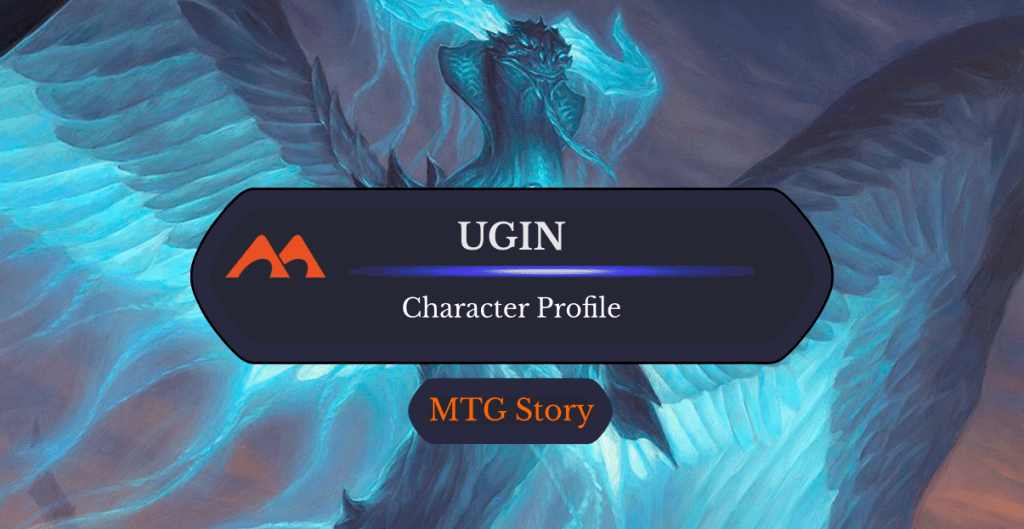
Ugin, the Spirit Dragon | Illustration by Chris Rahn
Some Magic characters are pretty straightforward while others need a little more explanation. New players might see a massive silver golem or a hollow metal man with a clawed hand and assume that there’s some backstory to these characters. And, for the most part, you'd be right.
Usually depicted as a glowing blue dragon with angel wings, it’s clear at first glance that Ugin isn’t your average dragon. His massive horns, reminiscent of Nicol Bolas’, also give him a distinct look. But Ugin isn’t just one of the most unique-looking characters; he's also played a major role in several big storylines across Magic’s history.
Ugin’s efforts have helped several different planes including Tarkir and Zendikar. He was also instrumental in helping win the War of the Spark against Nicol Bolas. Who is Ugin, and why is he so powerful? Let's dive in and find out!
Who Is Ugin?
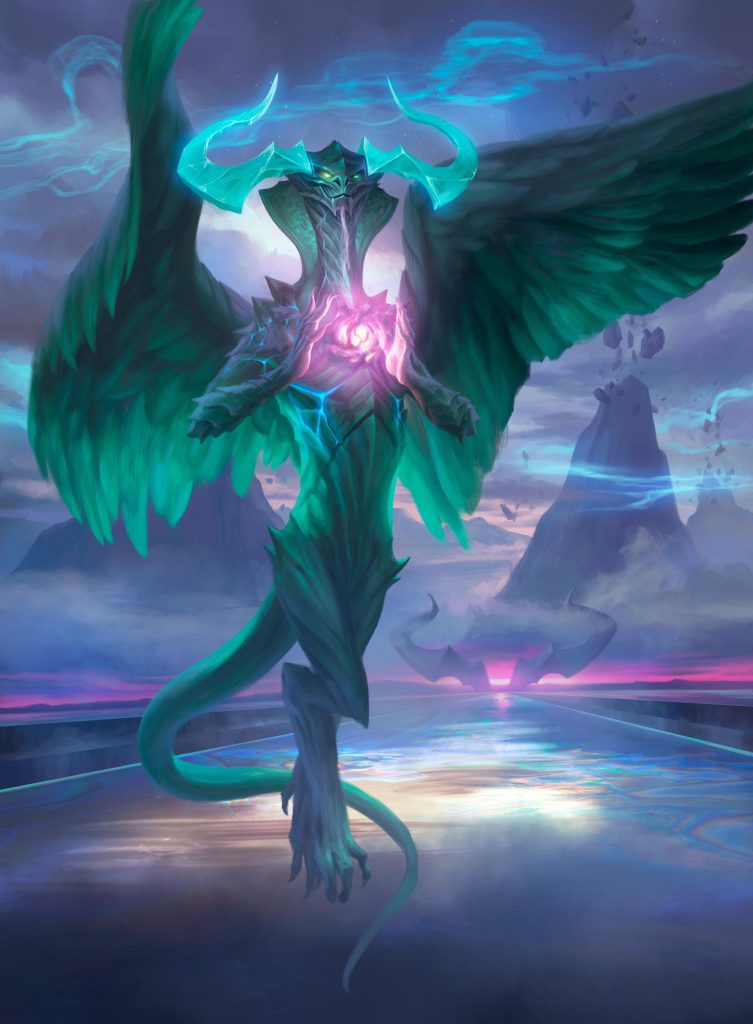
Ugin, the Ineffable | Illustration by Daarken
Ugin is one of the original Elder Dragons who were birthed from The Ur-Dragon. Ugin’s spark ignited after a shocking revelation and he planeswalked to the Meditation Plane. As both an Elder Dragon and a planeswalker, Ugin is an incredibly powerful being capable of using all five colors of mana. He's also transcended the use of colored mana entirely, now able to wield colorless mana.
Despite his imposing form and immense power, Ugin is a benevolent figure. He's served as an ally to many planeswalkers including Sarkhan Vol, Sorin Markov, and Nahiri. More recently Ugin aided Jace Beleren of the Gatewatch both on Zendikar and Ravnica.
List of Ugin Cards
As of now there are only two Ugin cards in the game. Both are relatively powerful just like Ugin in the lore.
Ugin, the Spirit Dragon
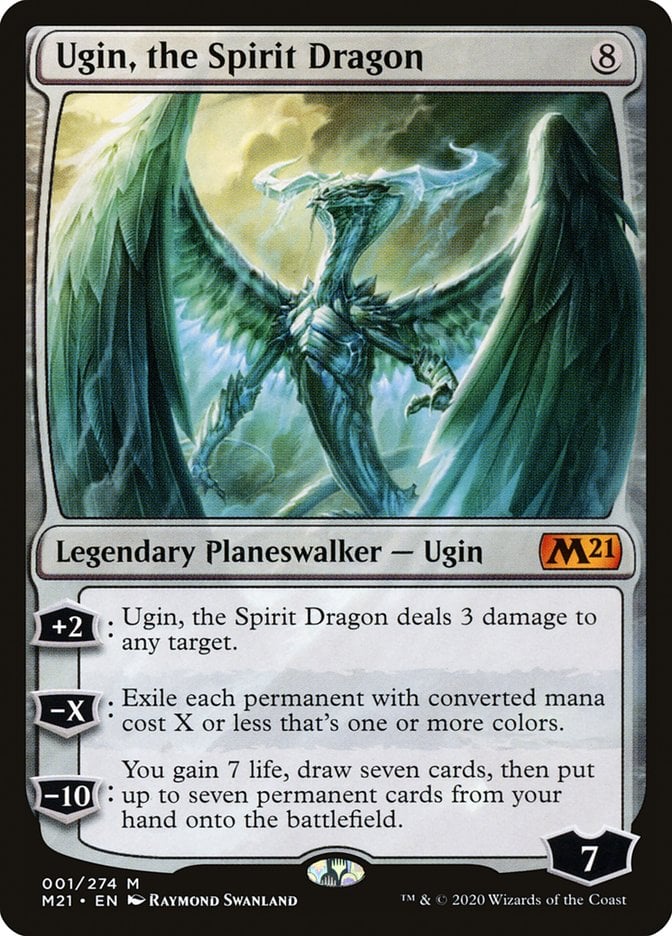
Ugin, the Spirit Dragon is a pretty expensive planeswalker, but it’s well worth the price. It has two powerful forms of removal, especially the built-in board wipe. Its ultimate ability can put you very far ahead of your opponent(s) and will likely put you in a position to win the game.
Ugin, the Ineffable
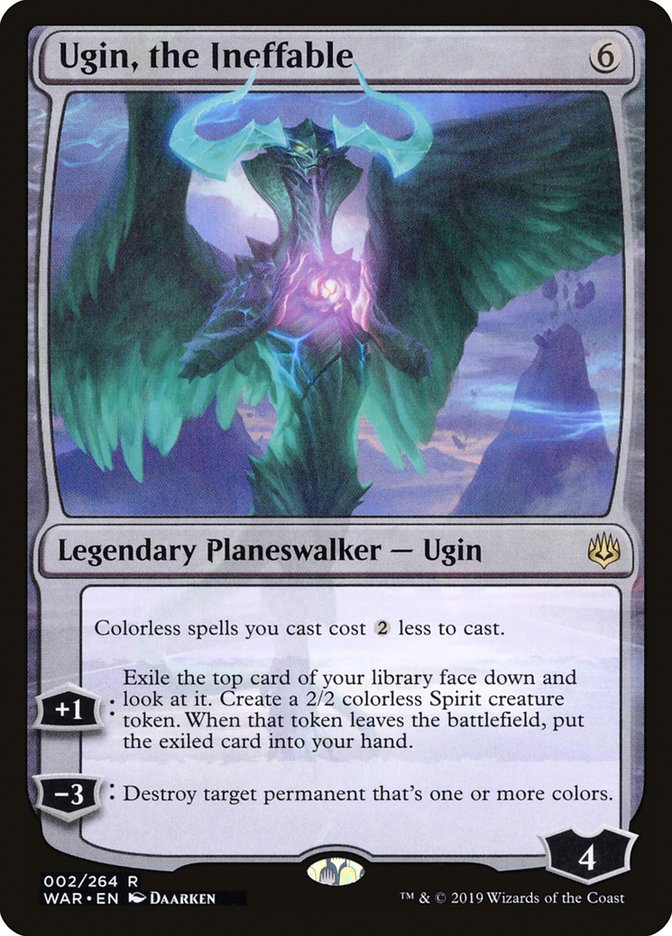
Ugin, the Ineffable might not have the same immediate impact as Ugin, the Spirit Dragon, but it can still be a very effective card. Its cost reduction can be very powerful in artifact decks, especially since you can cast a lot of cheaper artifacts for free. This can allow you to cash in on payoffs from casting artifacts or historic spells like with Jhoira, Weatherlight Captain.
Ugin’s +1 ability is also a great way to create blockers, ones that you won’t mind letting die since you get a card out of it when they do. Though Ugin’s -3 will get it dangerously low on loyalty if played early on, it’s still a nice source of removal if you need it.
Ugin’s Backstory
Ugin was a flesh-and-blood Elder Dragon on the plane of Dominaria before he was a spirit dragon. After witnessing a pack of hunters and their dogs kill Merrevia Sal (a fellow Elder Dragon), Ugin sought to convene with the rest of his siblings and gain more knowledge to keep them safe. He then befriended Te Ju Ki, an elderly human who explained the other planes of the multiverse to Ugin.
After learning what he could from Te Ju Ki, Ugin headed back to the mountain where he was born with his twin elder dragon, Nicol Bolas. He was wounded by dragon hunters on the way, who Bolas quickly manipulated and conquered. Nicol Bolas even tried to use Ugin as a pawn in his plans. This was such a shock to Ugin that his spark ignited and he became a planeswalker.
Ugin began traveling the multiverse, learning much about the worlds beyond Dominaria. When he finally returned to his home plane he was surprised to find a war raging between the Elder Dragons. Nicol Bolas tried to sway Ugin to join his side but he refused, leading to the two falling out for good.
How Do You Pronounce Ugin?
There’s some debate in the Magic community on how to pronounce Ugin, but the official pronunciation is oo/g/-in with a hard “g” as in “game.”
Some players believe that his name is pronounced like “Eugene,” but this is false. It’s an effective way to annoy your fellow players, though, if you feel like starting an argument at your LGS.
Is Ugin Dead?
Ugin has died several times, but he isn’t technically dead. After being killed in the Meditation Plane his body reformed itself from the magical water-like substance that makes up the realm. Ugin is still alive even though he no longer has his original body.
Who Killed Ugin?
Ugin has died twice, both times killed by Nicol Bolas. The first time was when Bolas killed him in the Meditation Plane, leading to him losing his original body. The two fought again years later on the plane of Tarkir, and once again Bolas “killed” Ugin.
Who Saved Ugin?
After being killed by Nicol Bolas a second time, Ugin’s spirit managed to reach out to the planeswalker Sarkhan Vol. Returning to his home plane of Tarkir, Sarkhan sought a way to help Ugin. Sarkhan traveled back to just before Nicol Bolas killed Ugin with the help of Ugin's Nexus. He managed to save Ugin, which in turn changed the entire history of Tarkir.
Where Is Ugin?
Ugin managed to trap a desparked Nicol Bolas on the Meditation Plane after the War of the Spark. Ugin explained how he had managed to defeat Bolas and then dissolved his body to spread himself across the entire plane. This way he could stop anyone from ever entering or leaving the Meditation Realm again, ensuring that Bolas would eventually die of old age and be unable to cause any further harm.
How Old Is Ugin in MTG?
Ugin was born -25,000 AR. The present year in Magic is 4,562 AR, so Ugin is 29,562 years old. Ugin is one of the oldest characters in Magic who's still alive and was around even before the creation of Phyrexia.
Is Ugin Related To Nicol Bolas?
Yes, like all Elder Dragons, Nicol Bolas and Ugin are siblings. But the two share an even closer bond: they were the only two Elder Dragons born as twins in the same egg. The two also only had one name while the other Elder Dragons had two. Nicol later adopted the name Bolas so that he wouldn’t feel inferior to the other larger Elder Dragons while Ugin kept his one name.
It’s because Nicol and Ugin are twins that Bolas’ betrayal hurt Ugin badly enough to ignite his spark. This is also why the two dragons bear a resemblance to one another, like having the same horns.
How Did Ugin Become A Spirit Dragon?
Ugin became a spirit dragon when Nicol Bolas first killed Ugin in the Meditation Realm and his body reformed itself. Ugin seems to be the only spirit dragon of his kind in Magic’s story, and his origins and abilities differ greatly from the Dragon Spirits of Kamigawa.
Does Ugin Count as a Dragon?
No. Neither Ugin, the Spirit Dragon nor Ugin, the Ineffable counts as a dragon card. Dragon is a creature subtype and needs to be present on a card’s typeline for that card to be considered a dragon. Ugin’s typeline on both his cards just reads “Legendary Planeswalker – Ugin,” so neither card counts as a dragon.
Is Ugin, the Spirit Dragon Good?

Ugin, the Spirit Dragon is a very good planeswalker. Its casting cost is high but not restrictive, so it’s easy to ramp for it using lands and mana rocks that produce multiple colorless mana. Its mass removal ability doesn’t target colorless permanents, so Ugin, the Spirit Dragon works very well in artifact-heavy decks.
And even if you don’t ever get its ultimate ability off its first two are great for defending both Ugin and yourself, making Ugin, the Spirit Dragon a useful piece to have on the board.
How Does Ugin, the Spirit Dragon Work?

Ugin, the Spirit Dragon’s +2 ability is pretty straightforward. It’s basically like casting a free Lightning Bolt, allowing you to ping any target for three damage.
Ugin’s ultimate ability is also relatively straightforward, but it’s important to remember that the seven permanents you choose from your hand don’t have to be ones you just drew. If you’ve been holding onto a high-mana permanent, you can drop that instead of a new card. The ability allows for any permanent in your hand to be put onto the battlefield. It’s also important to remember that this doesn’t count as casting the card.
Ugin, the Spirit Dragon’s most complicated ability is its -X ability, which allows you to choose how many loyalty counters you want to remove from Ugin. All permanents with mana value less than the X value you chose will be exiled if they’re one or more colors.
Keep in mind that lands, even if they tap for colored mana, are considered colorless. Tokens also have no mana value unless they’re an exact copy of another permanent. You can activate Ugin’s second ability with an X value of 0 and still wipe out all the tokens on the board.
Can Ugin, the Spirit Dragon Target Planeswalkers?

Yes, Ugin, the Spirit Dragon’s +2 ability allows you to damage any target, including planeswalkers. You can also target players or creatures.
Is Ugin, the Ineffable Good?

I think Ugin, the Ineffable can work well in the right decks. Its cost reduction is great for casting expensive artifacts or colorless creatures like Eldrazi. It’s also helpful for playing low-cost artifacts for free, allowing you to drop cheap mana rocks for no mana.
Ugin’s other abilities are also pretty good. Its +1 is interesting because it can give you a much-needed blocker and an extra card. You can also keep the Spirit token around as long as you need it if the card you exile isn’t that important. The -3 is a big cost with only 4 starting loyalty, but it’s still nice that this planeswalker can act as removal right away if you’re in desperate need.
How Does Ugin, the Ineffable Work?

Ugin, the Ineffable’s cost reduction ability is a passive one. You don’t have to activate it, you just pay less for colorless spells as long as it's on the field. The -3 ability is also pretty straightforward, just remember that lands are colorless and can’t be targeted as with the other Ugin’s board wipe.
Ugin’s +1 ability is a little bit more complicated. You place the top card of your library face down in exile and put a 2/2 Spirit token on the battlefield when you activate this ability. A lot of players choose to put the card from the top of their deck below the Spirit token or even just flip that card upside down on the field to act as the Spirit.
It’s important to remember that the card is technically in exile even if the player chooses to put it in place of or under the token. There’s also no way to remove the card that's been exiled; only the token can be removed. You can add the exiled card to your hand as soon as the token is destroyed, exiled, or bounced.
How Much is Ugin, the Ineffable Worth?
Ugin, the Ineffable has a market price of just under $4 on TCGPlayer. If you’re after a flashier version of the card, the Japanese alternate art version has a market value of around $5 while the Secret Lair stained glass version of Ugin has a market price of around $25.
Bonus: Ugin in Oathbreaker
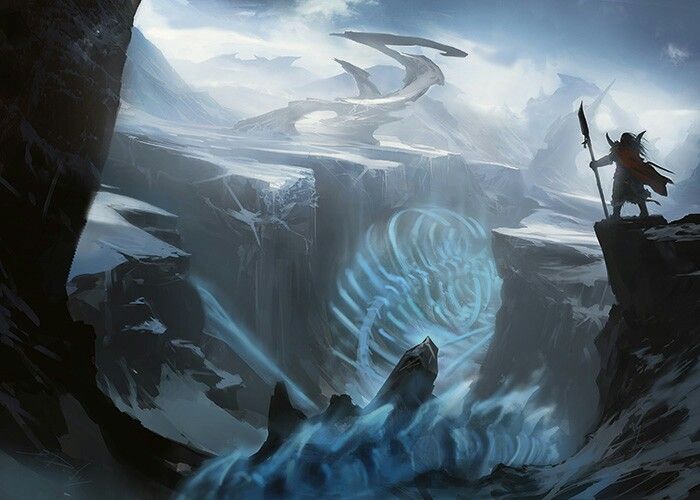
Tomb of the Spirit Dragon | Illustration by Sam Burley
Oathbreaker (1)
Signature Spell (1)
Planeswalker (1)
Creatures (14)
Cathodion
Darksteel Juggernaut
Duplicant
Jhoira's Familiar
Kuldotha Forgemaster
Metalwork Colossus
Metalworker
Myr Battlesphere
Steel Hellkite
Voltaic Construct
Walking Ballista
Wurmcoil Engine
Liberator, Urza's Battlethopter
Emrakul, the Promised End
Instants (2)
Scour from Existence
Warping Wail
Artifacts (20)
Akroma's Memorial
Ashnod's Altar
Basalt Monolith
Everflowing Chalice
Expedition Map
Fellwar Stone
Fractured Powerstone
Krark-Clan Ironworks
Mind Stone
Mind's Eye
Nim Deathmantle
Oblivion Stone
Prismatic Lens
Rings of Brighthearth
Sunset Pyramid
Tamiyo's Journal
Thought Vessel
Umbral Mantle
Unstable Obelisk
Forsaken Monument
Lands (21)
Ancient Tomb
Arcane Lighthouse
Arch of Orazca
Blast Zone
Buried Ruin
Darksteel Citadel
Emergence Zone
Ghost Quarter
Haunted Fengraf
Inventors' Fair
Mystifying Maze
Reliquary Tower
Rogue's Passage
Sea Gate Wreckage
Shrine of the Forsaken Gods
Tomb of the Spirit Dragon
Urza's Mine
Urza's Power Plant
Urza's Tower
Urza's Workshop
Temple of the False God
When thinking about what kind of Ugin deck to include I decided to go outside the box and present a deck for an obscure format: Oathbreaker.
For the uninitiated, Oathbreaker is a lesser-known spinoff of Commander where players use a planeswalker along with an instant or sorcery (called a signature spell) in lieu of a legendary creature in the command zone. Players can cast their chosen planeswalker just like Commander, but they need to have their planeswalker on the board to cast their signature spell. Similar to commander tax, both your planeswalker and signature spell are taxed every time you cast them.
I chose Ugin, the Ineffable to lead it because its cost-reduction ability can be very helpful in a colorless deck. For the signature spell I went with a nasty removal spell, All Is Dust, which forces players to sacrifice any permanent that’s one or more colors. What makes this so devastating is that players can’t regenerate their creatures to prevent this, and indestructible doesn’t prevent something from being sacrificed. And it also only costs five mana the first time you cast it thanks to Ugin.
Oathbreaker decks are usually quick and looking to combo off, so I included ways to generate infinite mana like Basalt Monolith and Rings of Brighthearth. You can pay off your infinite combos with a Walking Ballista. Just pump it with enough +1/+1 counters and then directly damage your opponents until they have no life.
Wrap Up

Ugin, the Spirit Dragon (Fate Reforged) | Illustration by Raymond Swanland
Hopefully you now know all you wanted to know about Ugin as a character and a planeswalker. Unfortunately it looks as though Ugin won’t be part of Magic’s story for a while, but Wizards definitely left the door open for his possible return. There are always Modern Horizons-type sets that print cards from the game’s past, so we might still get a new version of Ugin at some point.
Is there anything else you’d like to know about Ugin? Would you like to see him return? Would you want a double-sided Ugin similar to Nicol Bolas, the Ravager? Let me know in the comments or on the Draftsim’s Discord.
Thanks for reading, and I look forward to seeing you in the next one!
Note: this post contains affiliate links. If you use these links to make a purchase, you’ll help Draftsim continue to provide awesome free articles and apps.
Follow Draftsim for awesome articles and set updates: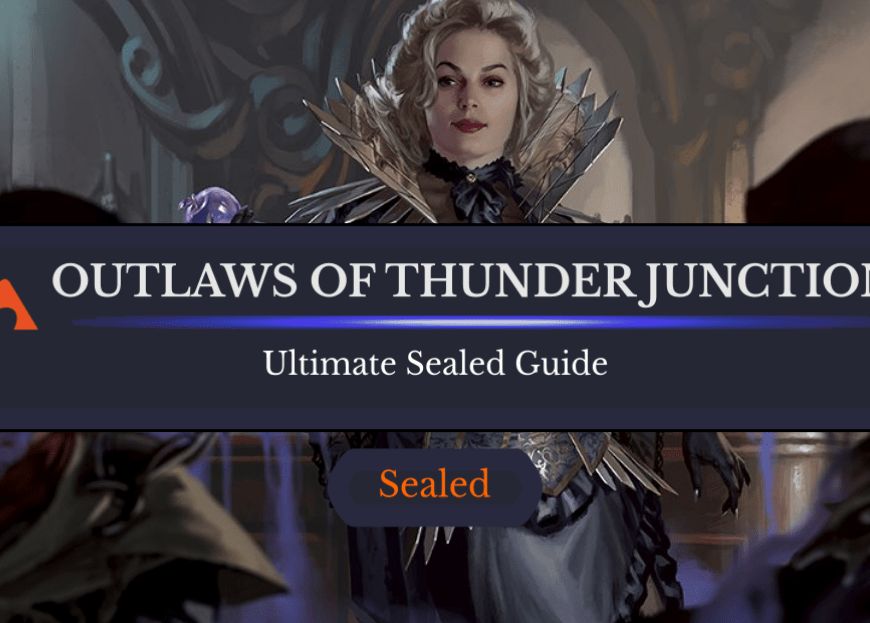

Add Comment